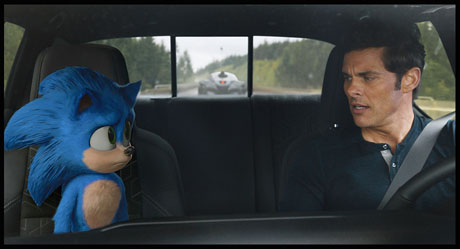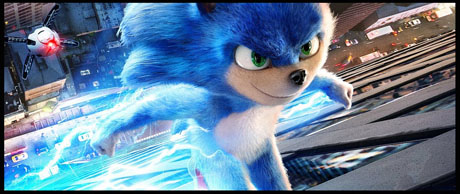
2019 was not a great year for animated wide-release theatrical films. Only three of them made the list of Academy Award nominations, and two of those were franchise sequels. Toy Story 4 was the deserving winner, but no one handicapping the Awards would have bet against that film. Many of the wide-release animated films of 2019 were flawed, formulaic, or failed in the basic execution of story, often in the service of feel-good messages. Sonic the Hedgehog is the first entry of 2020, and while it does have some entertainment value, it looks like we are in for more of the same.

Sonic began life in 1991 as a Sega video game, and soon found his way into several animated series; he predates several other animated superstars in this regard; only two years after the premiere of The Simpsons and eight years before SpongeBob Squarepants moved to Bikini Bottom, the cobalt blue speedster known as Sonic was already a recognized star. The character, designed by Naoto Oshima, was created to compete with Nintendo’s Mario games. Through several iterations of technology, Sonic (who makes Speedy Gonzales look immobile) battled the evil Dr. Eggman (later Robotnik) with the help of energy-replenishing power rings.
In the film (spoilers avoided) Sonic has been sent to Earth through one of his many power rings/dimensional portals to escape peril, his only possession his sack of said portals. He lives in seclusion in the small town of Green Hills Montana until he gives himself away by running recklessly around a baseball diamond, setting off a powerful electromagnetic pulse that knocks out most of the Northwest. This draws the attention of insane government super scientist Dr. Robotnik. Sonic is eventually befriended by police officer Tom Wachowski; events lead Sonic to lose his power rings; they end up on a wing of the Transamerica Building in San Francisco. Pursued by Dr. Robotnik and his army of sophisticated machines, Sonic and Wachowski set out to retrieve the all-important rings.
One would think that after nearly thirty years of adventures on and off the video screen, a movie could be made that would unite youth and their nostalgic elders, but this did not turn out to be the case. Sonic was directed by first-timer Jeff Fowler, who at least has an Academy Award nomination for an animated short. Fowler was signed on in 2016, not long before the rights were sold to Paramount by Sony. I don’t like to be rough on newbie directors unless they attempt to direct animated films when having no previous background in animation, so I’m going to go to the source of this film’s worst problem: This is one of the worst-scripted films I have seen in the past few years.
I am all for the willing suspension of disbelief, but Sonic the Hedgehog demands that disbelief be strung up by the thumbs. Writers Pat Casey and Josh Miller. One might recognize the names from the short-lived Fox animated series Golan the Insatiable. The story is filled with so many plot holes, plot lapses, improbabilities, and continuity mistakes that one could believe that it was thrown together in a single night over dinner (probably at Olive Garden). One can follow the story, which is more than I can say for last year’s Pokemon: Detective Pikachu, but that’s an awfully low bar to clear. It feels as if the script was crafted with careless disregard, as if Casey and Miller knew that the film’s target audience—kids—would neither notice, nor care about, how sloppy the whole enterprise was.

An early trailer for the film revealed a Sonic whose eyes and teeth were deemed to be incorrect and unattractive, setting off an Internet firestorm; you know how these things can be a matter of national importance. An artist who was a Sonic expert was hired to help out Marza Animation Planet, Trixter, Blur Studio, and Digital Domain. After a three-month delay in release date and an additional $5 million dollars, a version of Sonic emerged that satisfied everyone, including Sega. If only the same attention had been paid to other aspects of the film.
At any rate, Sonic is a very appealing CGI creation, and kudos should be handed out for all studio and artist efforts that went into his digital redesign after the initial missteps. The film reuses a special effect (twice) from the X-Men films featuring Quicksilver, but at least uses it well during a bar-fight scene.
Ben Schwartz, late of Parks and Recreation knocks it dead as Sonic; it would be hard to improve on his winning performance. Jim Carrey as Dr, Robotnik gives a wonderful throwback performance to the days before he began taking more serious roles and painting political cartoons; it’s truly good to have him back with this manic, goofy and supremely megalomaniacal role. Everyone else is, sadly, superfluous to the story; even the usually adept James Marsden is eclipsed by his speedy blue co-star.
In short, this is a bouncy, high-energy film with some fun moments and, occasionally, a genuine bit of heart, but it is hampered by some questionable moments and careless scripting. It will likely be a big seller on Blu-Ray and a welcome boost to Sega sales, but in the end, it is an all-too familiar effort with all-too familiar deficiencies.
If you wish to lambaste me for trying to hold a movie about a blue video game hedgehog to higher standards, so be it; but why were so many of last year’s films hampered by the same lack of forethought or continuity? Such thoughts lead me to fear that big-screen theatrical animated films (with a few exceptions) have peaked as an art; that features will become increasingly formulaic, and that their entertainment value will wane even as their budgets increase. I continually hope that animation technology and story will continue to evolve together in a soaring marriage of artistic triumph. That does not happen in Sonic the Hedgehog, but I’m not giving up hope yet.
- ANIME REVIEW: “Lonely Castle in the Mirror” - September 24, 2023
- REVIEW: “Teenage Mutant Ninja Turtles: Mutant Mayhem - August 15, 2023
- REVIEW: “Spider-Man: Across The Spider-Verse” - June 7, 2023


 February 16th, 2020
February 16th, 2020  Martin Goodman
Martin Goodman  Posted in
Posted in  Tags:
Tags: 






